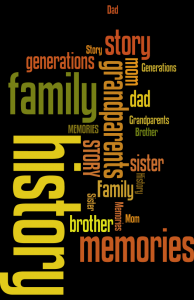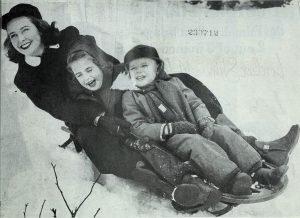Did you make a resolution to be kinder this year? The many elderly in your sphere of interaction are a great place to start. They’ve seen more than you can imagine and are often eager to share their stories. Next time you’re “stuck” behind someone creeping along with their walker, repeating the same story you’ve heard 50 times, or needing help with basic life skills, the following article will give you pause for thought. This story has been making the rounds and the original author is unknown, but as writer, producer and broadcaster Adrian Vance said when I contacted him for permission to print,
“a great story deserves a life.”
(Vance edited and shared this piece contributed by John Dusek on his blog https://adrianvance.blogspot.com/ June 27, 2017. I received it courtesy of a memoir client and veteran dealing with the health impacts of Agent Orange. Note–the woman on the right in the photo is my own Great Aunt Caroline on the eve of D Day)
CHILDREN OF THE GREATEST GENERATION
Born in the 1930s and early
40s, we exist as a very special age cohort. We are the Silent Generation.
We are the smallest number of children born since the early
1900s. We are the “last ones.”
We are the last generation, climbing out of the depression, who can
remember the winds of war and the impact of a world at war which rattled the
structure of our daily lives for years.
We are the last to remember ration books for everything from
gas to sugar to shoes to stoves.
We saved tin foil and poured fat into tin cans.
We saw cars up on blocks because tires weren’t available.
We can remember milk being delivered to our house early in the
morning and placed in the milk box on the porch.
We are the last to see the gold stars in the front windows of our
grieving neighbors whose sons died in the War.
We saw the ‘boys’ home from the war, build their little houses.
We are the last generation who spent childhood
without television; instead, we imagined what we heard on the radio.
As we all like to brag, with no TV, we spent our
childhood “playing outside”.
We did play outside, and we did play on our own.
There was no little league.
There was no city playground for kids.
The lack of television in our early years meant, for most of us,
that we had little real understanding of what the world was like.
On Saturday afternoons, the movies, gave us newsreels of the
war sandwiched in between westerns and cartoons.
Telephones were one to a house, often shared (party Lines) and hung on the
wall.
Computers were called calculators, they only added and were hand cranked;
typewriters were driven by pounding fingers, throwing the carriage, and
changing the ribbon.
The internet and GOOGLE were words that did not exist.
Newspapers and magazines were written for adults and the news was broadcast
on our table radio in the evening by Gabriel Heatter.
We are the last group who had to find out for ourselves.
As we grew up, the country was exploding with growth.
The G.I. Bill gave returning veterans the means to get an education
and spurred colleges to grow.
VA loans fanned a housing boom.
Pent up demand coupled with new installment payment plans put factories
to work.
New highways would bring jobs and mobility.
The veterans joined civic clubs and became active in politics.
The radio network expanded from 3 stations to thousands of stations
Our parents were suddenly free from the confines of the depression
and the war, and they threw themselves into exploring opportunities they had
never imagined.
We weren’t neglected, but we weren’t today’s all-consuming family
focus.
They were glad we played by ourselves until the street lights came
on.
They were busy discovering the post war world.
We entered a world of overflowing plenty and opportunity; a world
where we were welcomed.
We enjoyed a luxury; we felt secure in our future.
Depression poverty was deep rooted.
Polio was still a crippler.
The Korean War was a dark presage in the early 50s and by mid-decade school
children were ducking under desks for Air-Raid training.
Russia built the Iron Curtain and China became Red
China ..
Eisenhower sent the first ‘advisers’ to Vietnam.
Castro set up camp in Cuba and Khrushchev came to
power.
We are the last generation to experience an interlude when there
were no threats to our homeland.
We came of age in the 40s and 50s. The war was over and the
cold war, terrorism, global warming, and perpetual economic insecurity had
yet to haunt life with unease.
Only our generation can remember both a time
of great
war, and a time when our world was secure and full of bright
promise and plenty We have lived through both.
We grew up at the best possible time, a time when the world was
getting better. not worse.
We are the Silent Generation
“The Last Ones”
More than 99% of us are either retired or deceased, and we
feel privileged to have “lived
in the best of times”!

 It’s a cold, snowy day here, pretty rare for southern New Mexico. Days like this turn many of us into gleeful 5 year olds and snow photos show up on our social media feeds, usually featuring goofy family members and pets frolicking in the fluffy white stuff or beautiful landscapes.
It’s a cold, snowy day here, pretty rare for southern New Mexico. Days like this turn many of us into gleeful 5 year olds and snow photos show up on our social media feeds, usually featuring goofy family members and pets frolicking in the fluffy white stuff or beautiful landscapes. Sooo—I don’t know what your Christmas holiday preparations look like, but here’s a peek at mine—The good, the bad and the ugly. Today has been full of wrapping up of loose ends and daydreaming (creative planning) for future projects. I’ve spent a couple hours scanning historical 100 year old photos for a business client. Then, dropped off a big plate of delicious homemade fudge and Christmas wishes at their office.
Sooo—I don’t know what your Christmas holiday preparations look like, but here’s a peek at mine—The good, the bad and the ugly. Today has been full of wrapping up of loose ends and daydreaming (creative planning) for future projects. I’ve spent a couple hours scanning historical 100 year old photos for a business client. Then, dropped off a big plate of delicious homemade fudge and Christmas wishes at their office. Santa brought me an early new toy– a cookbook template I’d love to fill with your favorite recipes, photos and memories surrounding your family gatherings. Graduations, pre-Christmas parties, weddings and friendly pot-lucks are already gearing up early this month and every one of them has wonderful food. Party chit-chat often involves traditional family favorites or new dishes people want to try. We love those treats! Our desire to eat three times a day drives a creative enthusiasm around the topic of delicious food.
Santa brought me an early new toy– a cookbook template I’d love to fill with your favorite recipes, photos and memories surrounding your family gatherings. Graduations, pre-Christmas parties, weddings and friendly pot-lucks are already gearing up early this month and every one of them has wonderful food. Party chit-chat often involves traditional family favorites or new dishes people want to try. We love those treats! Our desire to eat three times a day drives a creative enthusiasm around the topic of delicious food.
 We love to hear our elders reminisce about holidays. Their memories help tie families together and strengthen bonds. These gatherings sometimes bring challenges but they sure do stick in our hearts and minds. The topic of holidays is great material for story gathering, especially for the younger generations who’d love to know what your childhood was like. So much changes over the decades, world events, technology, customs — open up the door for a sneak peek into this part of your story. Make sure you add in some of these details as you go through the following questions. You’ll all be glad you did.
We love to hear our elders reminisce about holidays. Their memories help tie families together and strengthen bonds. These gatherings sometimes bring challenges but they sure do stick in our hearts and minds. The topic of holidays is great material for story gathering, especially for the younger generations who’d love to know what your childhood was like. So much changes over the decades, world events, technology, customs — open up the door for a sneak peek into this part of your story. Make sure you add in some of these details as you go through the following questions. You’ll all be glad you did. Celebrate Agriculture! Whatever language you say it in, shout it loud this fall. I’ve been crazy busy this week getting ready to celebrate the 100th Anniversary of an irrigation district in southern New Mexico. It’s fun to be part of telling the story. I’ve been immersed in great photos old and new of hardworking people building, farming, irrigating and otherwise engaged in the age old struggle to produce food, clothing and shelter. It’s humbling and awe inspiring.
Celebrate Agriculture! Whatever language you say it in, shout it loud this fall. I’ve been crazy busy this week getting ready to celebrate the 100th Anniversary of an irrigation district in southern New Mexico. It’s fun to be part of telling the story. I’ve been immersed in great photos old and new of hardworking people building, farming, irrigating and otherwise engaged in the age old struggle to produce food, clothing and shelter. It’s humbling and awe inspiring.